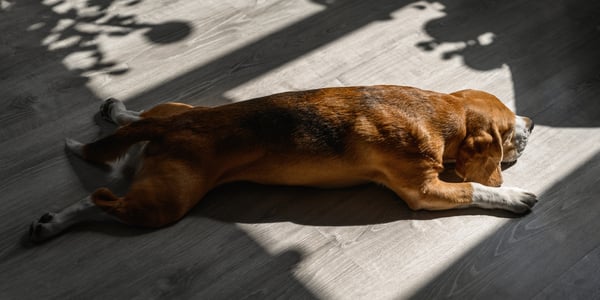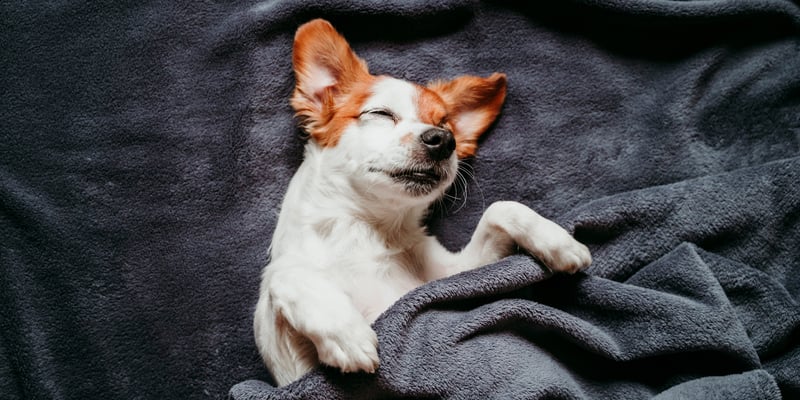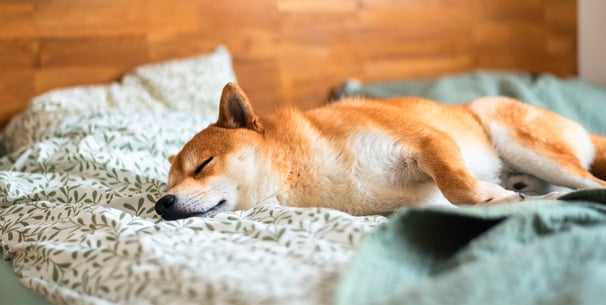Understanding Dog Sleeping Positions - What They Mean for Your Pet
Index:



Introduction to dog sleeping positions: what they mean about your pet
Dogs, much like humans, have unique ways of sleeping that can reveal a lot about their health, personality and comfort levels.
If you're wondering why does my dog sleep in this position? Then you're in the right place.
Understanding the meaning behind some common sleeping positions can help you better care for your furry friend.
In this comprehensive guide, we explore everything from sleeping curled up in a ball to dreaming flat out with their legs in the air.
What are their meanings, and how can they inform you about your dog's well-being?
Common dog sleeping positions and their meanings
1. The donut



When a dog curls up into a tight ball, resembling a donut, it typically signifies warmth and protection.
This position helps conserve body heat and protects vital organs. It’s common in colder weather or among dogs that feel vulnerable.
2. The side sleeper



A dog lying on its side with their legs extended indicates relaxation and trust.
Dogs in this position are comfortable in their environment and feel safe enough to expose their vital organs. It's a sign of contentment and deep sleep.
3. The Superman



Dogs stretched out with their limbs extended, resembling a flying superhero, are often in a light sleep or ready to spring into action.
This position is common in playful and energetic dogs, showing they are comfortable but alert.
4. The cuddler



Dogs that sleep snuggled up to their owners or other pets demonstrate affection and a desire for closeness.
This behaviour is typical of puppies and dogs with strong bonds to their families. It’s a sign of trust and affection.
5. The lion's pose



In the lion's pose, a dog rests with its head on its paws, similar to the majestic lion.
This position signifies rest rather than deep sleep, indicating that the dog is in a state of relaxation but ready to get up and move if needed.
6. The back sleeper



A dog lying on their back with paws in the air is the ultimate sign of comfort and trust.
This position is a sign that the dog feels completely secure in its environment and can regulate its body temperature more effectively.
What these positions reveal about your dog's health
Understanding your dog’s sleeping positions can also provide insight into their health:
Curled up (donut): This position may indicate they are cold or feeling insecure.
Side sleeper: Generally a sign of a relaxed and happy dog.
Superman: Shows energy and readiness to play.
Cuddler: Reflects strong social bonds and affection.
Lion's pose: Indicates a dog is resting but remains alert.
Back sleeper: Dogs who sleep on their back can often signify that they feel very secure and content in their surroundings.
How to improve your dog's sleep quality
To ensure your dog gets the best sleep possible, consider the following tips:
1. Provide a comfortable bed
Invest in a high-quality dog bed that supports your pet’s size and sleeping preferences. Orthopaedic beds are ideal for older dogs or those with joint issues, while memory foam beds offer comfort for all ages. For a list of must-have dog products, check out this helpful guide.
2. Maintain a regular routine
Dogs thrive on routine. Establish a consistent schedule for feeding, walking, and bedtime to help your dog feel secure and relaxed.
3. Ensure a calm environment
Create a peaceful sleeping area free from loud noises and distractions.
If your dog is sensitive to sounds, consider using a white noise machine or calming music.
Dogs with anxiety may benefit from products designed to soothe them. Learn about top products for dogs with anxiety.
4. Monitor room temperature
Ensure the sleeping area is at a comfortable temperature. Provide blankets in cooler weather and a cool mat or tile floor space during hotter months.
5. Regular exercise
Adequate exercise helps your dog expend energy and can lead to more restful sleep.
Ensure your dog gets plenty of physical activity suitable for its breed and age.
6. Health check-ups
Regular veterinary visits are crucial to ensure your dog’s health.
Any sudden changes in sleeping habits or positions could indicate health issues that require professional attention. For more on dog health concerns, read this informative article.



Conclusion
Understanding your dog's sleeping positions can provide valuable insights into their well-being and comfort.
By recognising these positions and making appropriate adjustments to their sleeping environment, you can help ensure your furry friend enjoys restful and rejuvenating sleep.
Happy, well-rested dogs are more likely to be healthy, playful, and affectionate, enhancing the bond you share with your beloved pet.
Answers to your questions
What do different dog sleeping positions mean?
Different dog sleeping positions can indicate various things about their comfort, health and emotions.
For instance, when a dog sleeps curled up, it usually means they are conserving warmth and feel secure.
How can I help my dog sleep better?
Ensuring your dog has a comfortable and supportive dog bed, maintaining a calm environment and establishing a consistent routine can improve your pup’s sleeping habits.
Regular exercise and a balanced diet also contribute to better sleep patterns.
What does it mean if my dog sleeps with their head and neck raised?
When a dog sleeps with their head and neck raised, it often means that they are trying to breathe more easily.
This position usually means your dog might have respiratory issues or simply enjoys a more comfortable breathing angle.
Are there specific sleeping patterns for different dog breeds?
Yes, different dog breeds can exhibit unique sleeping patterns. Some breeds may be more prone to sleeping curled up, while others might enjoy sprawling out.
Understanding your dog’s breed-specific habits can help you interpret their sleeping positions and what they mean more accurately.
Why does my puppy sleep so much?
Puppies require a lot of sleep for growth and development. On average, a puppy may sleep 18-20 hours a day.
Noticing your dog adapting to routine sleep patterns indicates healthy growth and development.
What does the "superman" position in dogs mean?
The "superman" position, where the dog lies flat on their stomach with limbs stretched out, is one of the cutest dog sleeping poses.
This position usually means your dog is feeling playful and ready to jump up at any moment.
Is it okay to let my dog sleep in bed with me?
Letting your dog sleep in bed with you is a personal choice. It can strengthen the bond between you and your dog.
However, it's important to consider any allergies, sleep disruptions, or behaviour issues that may arise from sharing a bed.
What does it mean if my dog prefers to sleep on their back?
When a dog sleeps on their back, it typically means that they feel safe and secure in their environment.
This position also allows for maximum relaxation and can help them cool down, as the belly is exposed.
Can sleeping positions indicate health problems in dogs?
Yes, certain sleeping positions can indicate potential health issues. For example, a dog sleeping in a hunched position might be experiencing pain or discomfort.
Monitoring your dog’s sleep patterns and consulting a vet if you notice unusual changes is essential.
Why does my dog want to get under the covers while sleeping?
Some dogs enjoy the sensation of being under covers as it mimics a den-like environment, providing comfort and security.
This adorable dog sleeping habit can indicate a need for warmth or a sense of protection.
Understanding these sleeping positions not only aids in better care but also strengthens the bond between you and your furry companion.
For more tips on how to make your dog happy, visit this guide.
Waggel Pet Insurance
Need more help? You're in luck if you're a Waggel Pet Insurance member. Along with our excellent coverage, we offer access to a 24/7 online vet to answer all your sticky questions, especially if you need grooming assistance.
Not a member? Why not get a quote now and cover your furry friend for a range of illnesses, all while enjoying our amazing perks and rewards.
Want more like this?
Get updates from us with helpful info, advice, answers to frequently asked questions and much more.
Index:
Related posts:
Get your quote
Along with our excellent coverage, we offer access to a 24/7 online vet to answer all your sticky questions.





